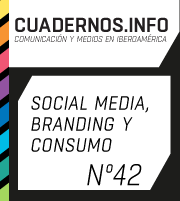¿Programando la creación? Una exploración al campo socio-técnico de YouTube en Chile
DOI:
https://doi.org/10.7764/cdi.42.1370Palabras clave:
plataformas digitales, Bourdieu, YouTube, atención, camposResumen
En los últimos años, se ha prestado gran atención a la influencia que tendrían las plataformas digitales en las prácticas creativas de sus usuarios. Mediante un análisis cualitativo de entrevistas con creadoras y creadores chilenos de contenido audiovisual en YouTube, mostraremos cómo sus prácticas creativas se sitúan dentro de un emergente campo socio-técnico en el que se lucha por diferentes formas de capital. Este campo presentaría dinámicas particulares de distinción, reconocimiento y consagración, que estarían activamente moldeadas por los complejos sistemas algorítmicos y métricas que configuran la valorización y monetización de los contenidos.
Descargas
Citas
Arriagada, A. (2014). Cultural Mediators and the Everyday Making of Digital Capital in Contemporary Chile (doctoral thesis, London School of Economics and Political Science). Retrieved from http://etheses.lse.ac.uk/913/
Andrejevic, M. (2009). Exploiting YouTube: contradiction of User-Generated Labor. In P. Vonderau, P. Snickars & G. Burgess (Eds), The YouTube Reader (pp. 406-423). Stockholm: National Library of Sweden.
Bijker, W. E. & Law, J. (1992). Shaping Technology/Building Society. Studies in Sociotechnical Change. Cambridge: MIT Press.
Bourdieu, P. (1969). Intellectual field and creative project. Social Science Information, 8(2), 89-119. https://doi.org/10.1177/053901846900800205
Bourdieu, P. (1993). The field of cultural production: Essays on art and literature. Columbia: University Press.
Bourdieu, P. & Wacquant, L. J. (1992). An invitation to reflexive sociology. Cambridge: Polity Press.
Burgess, J. & Green, J. (2009a). YouTube: Online video and participatory culture. Cambridge: Polity Press.
Burgess, J. & Green, J. (2009b). The Entrepreneurial Vlogger: Participatory Culture Beyond the Professional-Amateur Divide. In P. Vonderau & P. Snickars (Eds.), The YouTube Reader (pp. 89-107). Stockholm: National Library of Sweden.
Callon, M. (1986). Elements of a sociology of translation: Domestication of the Scallops and the Fishermen of St Brieuc Bay. In J. Law (Ed.), Power, Action and Belief: A New Sociology of Knowledge? (pp. 196-233). London: Routledge.
Campos Rodríguez, J. M. (2007). ¡Broadcast Yourself! Identidad, comunidad y masas inteligentes para la nueva sociedad del conocimiento [Broadcast Yourself! Identity, community and intelligent masses for the new knowledge society]. Revista ICONO14 Revista Científica de Comunicación y Tecnologías Emergentes, 5(1), 160-192. https://doi.org/10.7195/ri14.v5i1.376
Couldry, N. (2003). Media, symbolic power and the limits of Bourdieu’s field theory. Media@LSE Electronic Working Papers, 2. Department of Media and Communications, London School of Economics and Political Science, London, UK.
Duarte, F., Benevenuto, F., Almeida, V., & Almeida, J. (2007). Geographical Characterization of YouTube: a Latin American View. In Web Conference, 2007. LA-WEB 2007. Latin American (pp. 13-21). IEEE.
Gillespie, T. (2010). The politics of ‘platforms’. New Media & Society, 12(3), 347–364. https://doi.org/10.1177/1461444809342738
Gillespie, T. (2015). Platforms Intervene. Social Media + Society, 1(1). https://doi.org/10.1177/2056305115580479
Grusin, R. (2009). YouTube at the End of New Media. In P. Vonderau & P. Snickars (Eds.), The YouTube Reader (pp. 60-67). Stockholm: National Library of Sweden.
Howkins, J. (2001). The Creative Economy: How People Make Money From Ideas. New York: Penguin books.
Ignatow, G. & Robinson, L. (2017). Pierre Bourdieu: theorizing the digital. Information, Communication & Society, 20(7), 950-966. https://doi.org/10.1080/1369118X.2017.1301519
Jenkins, H., Ford, S., & Green, J. (2013). Spreadable Media. Creating value and meaning in a networked culture. New York: NYU Press.
Kim, J. (2012). The institutionalization of YouTube: From user-generated content to professionally generated content. Media, Culture & Society, 34(1), 53–67. https://doi.org/10.1177/0163443711427199
La Rotta, S. (2016, August 11). Latinoamérica es la región de YouTube que más crece en el mundo. Entérese por qué [Latin America is the YouTube region that grows the most in the world. Find out why]. El Espectador. Retrieved from http://www.elespectador.com
Lange, P. G. (2007). Commenting on comments: Investigating responses to antagonism on YouTube. In Society for Applied Anthropology Conference (Vol. 31, pp.163-190).
Lessig, L. (2008). Remix: Making art and commerce thrive in the hybrid economy. New York: Penguin Press.
Levina, N. & Arriaga, M. (2014). Distinction and Status Production on User-Generated Content Platforms: Using Bourdieu’s Theory of Cultural Production to Understand Social Dynamics in Online Fields. Information Systems Research, 25(3), 468-488. https://doi.org/10.1287/isre.2014.0535
López, A. (2016). Youtubers. Nueva lógica comercial y narrativa en la producción de contenidos para la web [Youtubers. New commercial and narrative logic in the content production for the web]. Revista L.I.S. Letra. Imagen. Sonido. Ciudad mediatizada, (15), 225-241. Retrieved from http://www.revistalis.com.ar/index.php/lis/article/view/225
Merton, R. K. (1968). The Matthew effect in science: The reward and communication systems of science are considered. Science, 159(3810), 56-63. https://doi.org/10.1126/science.159.3810.56
Morreale, J. (2014). From homemade to store bought: Annoying Orange and the professionalization of YouTube. Journal of consumer culture, 14(1), 113-128. https://doi.org/10.1177/1469540513505608
O’Reilly, T. (2005, September 30). What is Web 2.0. Design Patterns and Business Models for the Next Generation of Software. Retrieved from http://www.oreilly.com/pub/a/web2/archive/what-is-web-20.html
Postigo, H. (2016). The socio-technical architecture of digital labor: Converting play into YouTube money. New Media & Society, 18(2), 332-349. https://doi.org/10.1177/1461444814541527
Sabich, M. A. & Steinberg, L. (2017). Discursividad youtuber: afecto, narrativas y estrategias de socialización en comunidades de Internet [Youtuber Discursivity: Affection, narratives and socialization strategies in Internet Communities]. Revista Mediterránea de Comunicación, 8(2), 171-188. https://doi.org/10.14198/MEDCOM2017.8.2.12
Savage, M. (2013). Digital fields, networks and capital: Sociology beyond structures and fluids. In K. Orton-Johnson & N. Prior (Eds.), Digital Sociology (pp. 139-147). London: Palgrave Macmillan.
Siri, L. (2008). Un análisis de YouTube como artefacto sociotécnico [An analysis of YouTube as a socio-technical artefact]. Diálogos de la Comunicación, (77), 1-14. Retrieved from http://dialogosfelafacs.net/edicion-77/
Snickars, P. & Vonderau, P. (2009). Introduction. In P. Vonderau & P. Snickars (Eds.), The YouTube Reader (pp. 9-21). Stockholm: National Library of Sweden.
Soha, M. & McDowell, Z. J. (2016). Monetizing a Meme: YouTube, Content ID, and the Harlem Shake. Social Media + Society, 2(1), 1-12. https://doi.org/10.1177%2F2056305115623801
Sued, G. (2016). Formas distantes de ver YouTube: una exploración por la comunidad booktube [Distant ways to watch YouTube: an exploration by the booktube community]. Virtualis, 7(14), 90-112. Retrieved from http://aplicaciones.ccm.itesm.mx/virtualis/index.php/virtualis/article/view/189
van Dijck, J. (2016). La cultura de la conectividad: Una historia crítica de las redes sociales [The Culture of Connectivity: A critical history of social media]. Buenos Aires: Siglo Veintiuno.















